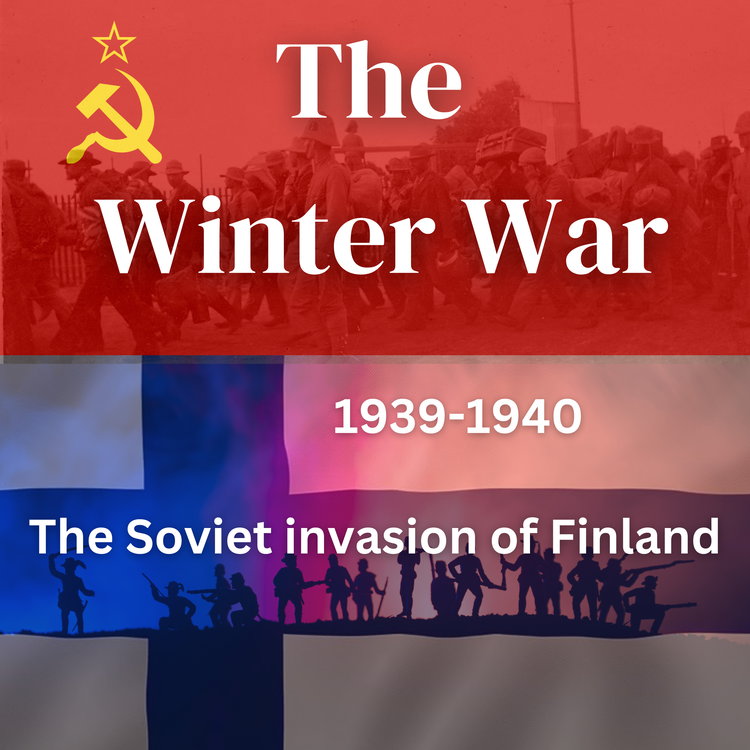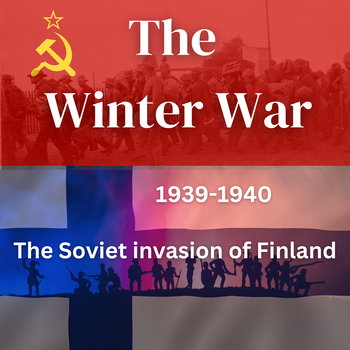
Episode 1 - Finland trapped between the Russian Bear and the German Wolf
Loading player...
The Russian invasion of Finland in November 1939 came as a bloody shock to the people of the small Baltic state, not least the government which appeared to have misread Joseph Stalin’s intentions.
The location for this terrible saga lies at the easternmost end of the Baltic Sea, between the Gulf of Finland and the huge Lake Ladoga, this is the rugged and very narrow Karelian Isthmus.
Flying over this territory in a light plane reveals its stark and stern beauty, cut laterally by crisp blue lakes, blanketed in an evergreen forest, stubby grey and reddy grey hills pop up here and there.
There was virtually nothing of value here at least at first, no minerals, very little agriculture as the soils are poor. That was going to change when the Finns discovered large deposits of nickel in the Petsamo region and would hand over mining concessions to the British.
The Russians did not like that one little bit.
But it wasn’t minerals that led to Moscow invading their much smaller neighbour, it was the fear of the Germans. This little bit of land was going to be fought over as it had been so often through history.
The Karelian Isthmus is a land bridge between the seething eastward mass of mother Russia and Asia, and the immensity of the Scandinavian Peninsular that swells downward to the west. It’s like a highway for tribal migration, a route for trade, a channel for cultural movements, and a gateway for conquest.
The armies that have stormed across this isthmus include the Mongols, the Teutons, Swedes, the Russians themselves. And as the drumbeat towards war in the 1930s pounded, Soviet president Joseph Stalin was acutely aware that the German’s could use this same route to attack Leningrad and Russia from the north west.
This Third Reich juggernaut could pass eastwards through the Karelian Isthmus at the point where it widens into the Finnish mainland, and hit Leningrad in a matter of hours. At least that was what Moscow convinced itself on the eve of World War II.
The fact that to get there the Germans would have to ship a vast quantity of material across the Baltic Sea was not really taken into account. It would have been a logistic nightmare which wasn’t really feasible at that stage of the war. Attacking via Sweden overland was even more difficult.
It made sense for Hitler and his generals to attack Leningrad, but using a far more common route via Lithuania. Leningrad is of course, St Petersburg, and St Petersburg is the hometown of Vladimir Putin. Another Russian leader who is paranoid about the Baltic States these days.
When the Russian revolution in November 1917 led to the Tsar’s overthrow, the Finns declared independence and Lenin could do very little — he was fighting his own civil war against the pro-Monarchy forces so Moscow initially recognized the new Finnish government.
Finland now experienced a series of social ructions, class struggles, famine, and a standard of living that plunged. There were 40 000 Russian soldiers stationed in Finland, and these joined the new Finnish communist Red Guard which began to fight the White Guard, the militant arm of the upper classes and the bourgeoisie. A Finnish Civil war had begun.
A right wing uprising in 1932 collapsed and that pretty much ended the effectiveness of the Finnish fascists, the country had survived the depression, coup attempts, fascist uprisings and their economy seemed to be looking up.
Moscow kept the pressure up saying that Finland had to prove their good faith with a tangible, real world gesture.
Finnish Prime Minister Cajander put out feelers, what would this entail? Ah, that’s easy, replied the Russians, the most suitable gesture would be for Finland to cede, or lease, what the communist country called “the valueless islands in the Gulf of Finland” to Russia.
Both Cajander and Holsti rejected this as out of the question.
The location for this terrible saga lies at the easternmost end of the Baltic Sea, between the Gulf of Finland and the huge Lake Ladoga, this is the rugged and very narrow Karelian Isthmus.
Flying over this territory in a light plane reveals its stark and stern beauty, cut laterally by crisp blue lakes, blanketed in an evergreen forest, stubby grey and reddy grey hills pop up here and there.
There was virtually nothing of value here at least at first, no minerals, very little agriculture as the soils are poor. That was going to change when the Finns discovered large deposits of nickel in the Petsamo region and would hand over mining concessions to the British.
The Russians did not like that one little bit.
But it wasn’t minerals that led to Moscow invading their much smaller neighbour, it was the fear of the Germans. This little bit of land was going to be fought over as it had been so often through history.
The Karelian Isthmus is a land bridge between the seething eastward mass of mother Russia and Asia, and the immensity of the Scandinavian Peninsular that swells downward to the west. It’s like a highway for tribal migration, a route for trade, a channel for cultural movements, and a gateway for conquest.
The armies that have stormed across this isthmus include the Mongols, the Teutons, Swedes, the Russians themselves. And as the drumbeat towards war in the 1930s pounded, Soviet president Joseph Stalin was acutely aware that the German’s could use this same route to attack Leningrad and Russia from the north west.
This Third Reich juggernaut could pass eastwards through the Karelian Isthmus at the point where it widens into the Finnish mainland, and hit Leningrad in a matter of hours. At least that was what Moscow convinced itself on the eve of World War II.
The fact that to get there the Germans would have to ship a vast quantity of material across the Baltic Sea was not really taken into account. It would have been a logistic nightmare which wasn’t really feasible at that stage of the war. Attacking via Sweden overland was even more difficult.
It made sense for Hitler and his generals to attack Leningrad, but using a far more common route via Lithuania. Leningrad is of course, St Petersburg, and St Petersburg is the hometown of Vladimir Putin. Another Russian leader who is paranoid about the Baltic States these days.
When the Russian revolution in November 1917 led to the Tsar’s overthrow, the Finns declared independence and Lenin could do very little — he was fighting his own civil war against the pro-Monarchy forces so Moscow initially recognized the new Finnish government.
Finland now experienced a series of social ructions, class struggles, famine, and a standard of living that plunged. There were 40 000 Russian soldiers stationed in Finland, and these joined the new Finnish communist Red Guard which began to fight the White Guard, the militant arm of the upper classes and the bourgeoisie. A Finnish Civil war had begun.
A right wing uprising in 1932 collapsed and that pretty much ended the effectiveness of the Finnish fascists, the country had survived the depression, coup attempts, fascist uprisings and their economy seemed to be looking up.
Moscow kept the pressure up saying that Finland had to prove their good faith with a tangible, real world gesture.
Finnish Prime Minister Cajander put out feelers, what would this entail? Ah, that’s easy, replied the Russians, the most suitable gesture would be for Finland to cede, or lease, what the communist country called “the valueless islands in the Gulf of Finland” to Russia.
Both Cajander and Holsti rejected this as out of the question.

